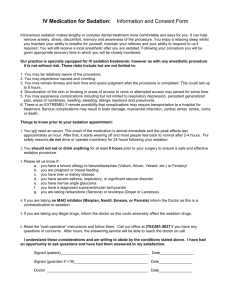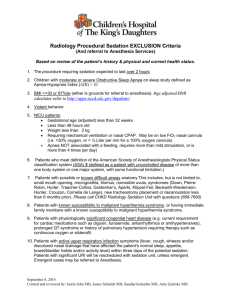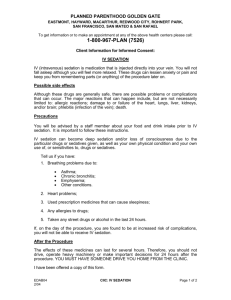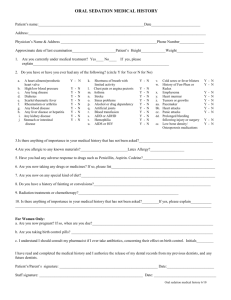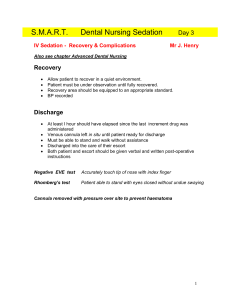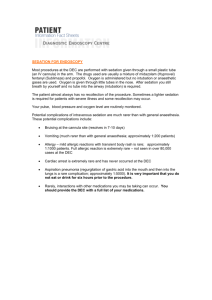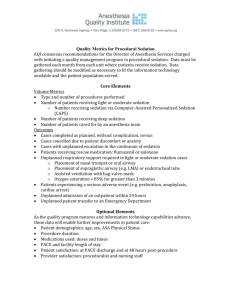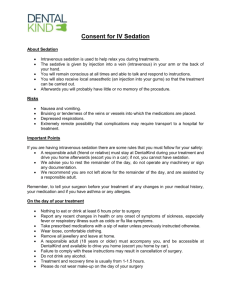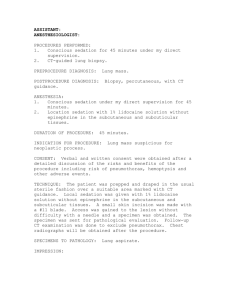Newsletter - Anesthesiology - Dartmouth
advertisement
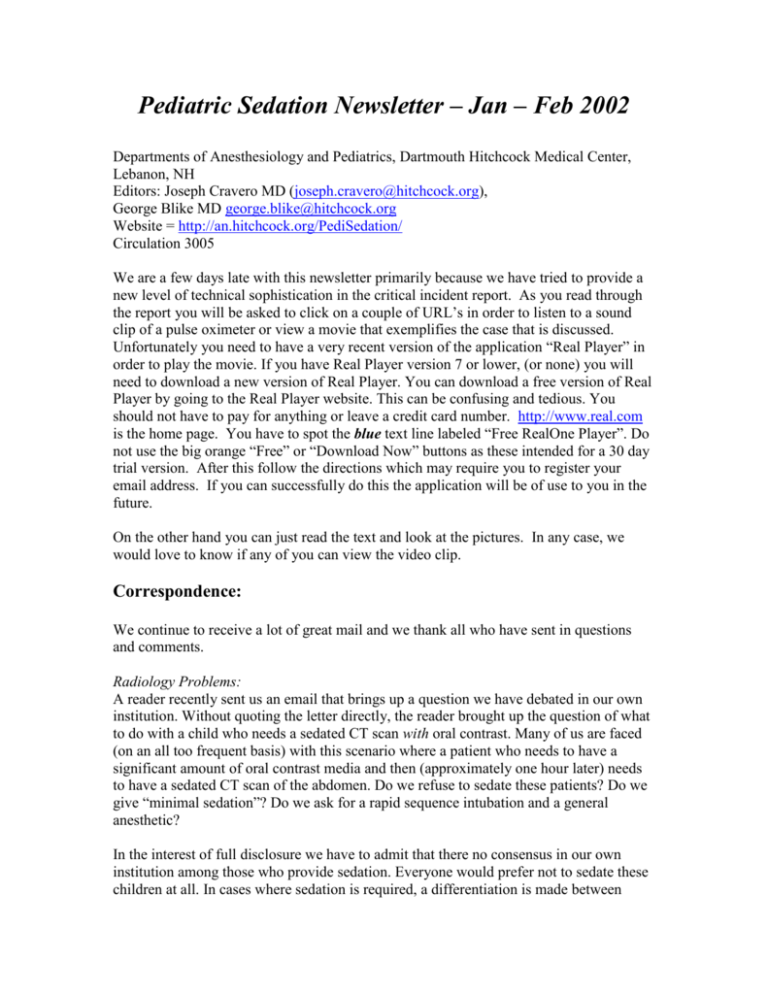
Pediatric Sedation Newsletter – Jan – Feb 2002 Departments of Anesthesiology and Pediatrics, Dartmouth Hitchcock Medical Center, Lebanon, NH Editors: Joseph Cravero MD (joseph.cravero@hitchcock.org), George Blike MD george.blike@hitchcock.org Website = http://an.hitchcock.org/PediSedation/ Circulation 3005 We are a few days late with this newsletter primarily because we have tried to provide a new level of technical sophistication in the critical incident report. As you read through the report you will be asked to click on a couple of URL’s in order to listen to a sound clip of a pulse oximeter or view a movie that exemplifies the case that is discussed. Unfortunately you need to have a very recent version of the application “Real Player” in order to play the movie. If you have Real Player version 7 or lower, (or none) you will need to download a new version of Real Player. You can download a free version of Real Player by going to the Real Player website. This can be confusing and tedious. You should not have to pay for anything or leave a credit card number. http://www.real.com is the home page. You have to spot the blue text line labeled “Free RealOne Player”. Do not use the big orange “Free” or “Download Now” buttons as these intended for a 30 day trial version. After this follow the directions which may require you to register your email address. If you can successfully do this the application will be of use to you in the future. On the other hand you can just read the text and look at the pictures. In any case, we would love to know if any of you can view the video clip. Correspondence: We continue to receive a lot of great mail and we thank all who have sent in questions and comments. Radiology Problems: A reader recently sent us an email that brings up a question we have debated in our own institution. Without quoting the letter directly, the reader brought up the question of what to do with a child who needs a sedated CT scan with oral contrast. Many of us are faced (on an all too frequent basis) with this scenario where a patient who needs to have a significant amount of oral contrast media and then (approximately one hour later) needs to have a sedated CT scan of the abdomen. Do we refuse to sedate these patients? Do we give “minimal sedation”? Do we ask for a rapid sequence intubation and a general anesthetic? In the interest of full disclosure we have to admit that there no consensus in our own institution among those who provide sedation. Everyone would prefer not to sedate these children at all. In cases where sedation is required, a differentiation is made between extremely high risk patients (those with any intestinal obstructive symptoms or those with marked gastroesophageal reflux) and otherwise well children. For those with high risk, many prefer to protect the airway with an endotracheal tube while “well” children are given sedation with a simple facemask oxygen. We have negotiated with our radiologists that the oral contrast is given 2 hours before the study and we find that there is usually little contents in the stomach at the time of the sedation. In some high risk patients with proximal pathology, the radiologists will accept contrast placed through an OG tube after an endotracheal tube is in place with a dwell time of 10-15 minutes. Each case needs to be discussed with the radiologist who will be reading that particular study to determine if this technique would be adequate for a given patient. As most of our readers will recognize, there is very little clear (evidence based) data on what the risk of aspiration is for children under sedation - in general. We could find no such data for sedated CT scans with oral contrast. Reports from the emergency medicine literature indicate that the incidence of aspiration during sedation (even in children considered to be “full stomach”) is extremely low. On the other hand we must ask what level of risk is acceptable for an elective CT scan? In light of the current lack scientific studies, a consensus concerning current practice for these studies may be the best we can do. We ask our readership (particularly radiologists) – what are the issues in your respective institutions and how are these studies handled? We will summarize the responses and publish summaries in the next newsletter. Sedation Education: Another interesting question came to us from a pediatric anesthesiologist at a children’s hospital struggling with the question of how to “certify” sedation providers. We do not have an anesthesia sedation team, and therefore, have a variety of physicians providing sedation for a variety of procedures. Our institution has decided that physicians need to be "certified" through the credentialing committee to provide sedation. It is my job to develop the "certification" process. I was curious as to what you do at your institution and if you know what other institutions are doing? Are there any standards that you know of? Are there accepted educational materials (booklets, videos, etc.) for purchase available? We have developed our own sedation course that includes a written didactic portion, a written test, and a hands-on simulator based practical session. Hospitals large and small across the country are trying to come to grips with how to meet the new JCAHO standards for training of sedation providers. As most of us are aware, while the standard to provide training and certification exists, there is little in the JCAHO literature to guide the formation of such a training course. We are not aware of proprietary courses available at this time, but it would not make sense for every hospital across the country to develop its own course as this would represent an incredible duplication of effort. We invite our readers to inform us on what is being done at their institutions and to provide information on any standardized sedation courses that are available. Once again we will condense this information and send it out to you in a future newsletter. Literature review: George M. Hoffman, Rhonda Nowakowski|, Todd J. Troshynski, Richard J. Berens, and Steven J. Weisman. Risk reduction in pediatric procedural sedation by application of an American Academy of Pediatrics/American Society of Anesthesiologists process model. PEDIATRICS Vol. 109 No. 2 February 2002, pp. 236-243 Abstract: Guidelines for risk reduction during procedural sedation from the American Academy of Pediatrics (AAP) and the American Society of Anesthesiologists (ASA) rely on expert opinion and consensus. In this article, the authors tested the hypothesis that application of an AAP/ASA-structured model would reduce the risk of sedation-related adverse events. Methods. Prospectively coded sedation records were abstracted by a hospital quality improvement specialist with practical and administrative experience in pediatric sedation. Process variables included notation of nulla per os (NPO) status, performance of a guided risk assessment, assignment of ASA physical status score, obtaining informed consent, generation of a sedation plan, and assessment of sedation level using a quantitative scoring system. Content variables included adherence to AAP NPO guidelines, ASA class, target sedation level, actual sedation level, age, procedure, and drugs used. Complication risk was assessed by logistic regression and Mantel-Haenszel odds ratios (OR). Results. Complications were identified in 40 of 960 records (4.2%). The complication rate was 34 of 895 (3.8%) with planned conscious sedation and 6 of 65 (9.2%) with planned deep sedation ([DS]; OR: 2.6). Complications were reduced by performance of structured risk assessment (OR: 0.10), adherence to all process guidelines (OR: 0), and avoiding actual DS (OR: 0.4). The only drug associated with higher risk was chloral hydrate (OR: 2.1). Failure to adhere to NPO guidelines did not increase risk in this assessment; however, the adverse event rate was 0 if all process guidelines were followed. Conclusions. Presedation assessment reduces complications of DS. Repeated assessment of sedation score reduces the risk of inadvertent DS. The data provide direct evidence that AAP/ASA guidelines can reduce the risk of pediatric procedural sedation. Commentary: This study from the Children’s Hospital of Wisconsin clearly represents a first step toward answering the long-held criticism of sedation guidelines – that adherence to a specific set of recommendations has never been shown to decrease the risk of sedation. For this effort alone all involved should be congratulated. This is a difficult task. In summary, the investigators evaluated almost 900 sedation records and assessed whether or not a standard AAP/ASA based structured model was followed. The records were then evaluated for the presence of complications related to the sedation and logistical regression methods were used to compare various factors relating to these groups. The authors begin by pointing out that adherence to practice standards has significantly decreased risk in the general anesthesia setting and hypothesize that adherence to a specific the AAP/ASA based structured model would similarly decrease the risk of sedation by non-anesthesiologists in a children’s hospital setting. The study is quite complex in its methodology and interested readers should review it in its entirety. The discussion section is extensive and in it the authors recognize the strengths and weaknesses of their own work and review the evidence for their conclusions. As this study will no doubt be widely quoted and discussed we feel compelled to bring up a few points that will certainly be raised as the merits of this study are debated: 1. While the abstract methods section starts with the terminology “prospectively coded sedation records were abstracted” – this study boils down to a sophisticated chart review of all sedations that took place in this institution during a several month period in 1999 (after a policy for a uniform sedation process was implemented). The weaknesses associated with this type of study are well known and recognized by the authors in the discussion section of the paper. The investigators are relying on accurate charting of sedation data by individuals performing sedation who did not necessarily know this information would be used as data for study analysis in the future – anyone who gives sedation regularly knows this is a leap of faith. In addition, the methodology of this study does not allow for blinding of the data gathering agent. 2. Readers must accept what is considered a meaningful “complication”. The study was undertaken to evaluate the safety of sedation practice, yet there is a wide variety of issues that are included under the heading of “complication” including “failed sedation” and “inadequate sedation”. (The complications are divided into different groups but all are used as part of the analysis.) Do some of these complications represent measures of safety risk or process effectiveness? In addition, there were no episodes of temporary injury, permanent injury, or death in any of the records - regardless of whether or not the structured process was followed. In order to accept the idea that the structured process really makes a difference for these important safety outcomes, we must accept that the minor complications that lead to “process variation” or “care escalation” (such as repositioning of the airway) are surrogate markers of greater risk. (i.e. we would have to assume that if the authors evaluated a large enough cohort, serious outcome differences would be evident in patients who experienced the complications that were observed). 3. As the study is not controlled or randomized, we can not be sure that patients who were higher risk were not treated somewhat differently from the lower risk patients. As the authors point out, although no relationship was found between aspiration risk and “full stomach” status, these patients probably received a lesser degree of sedation because of aspiration concerns. 4. This study represents data from only one institution. As we all recognize, pediatric sedation practice is highly non-standardized from one institution to another; it is very hard to conclude that the same findings would necessarily be present in another institution with a much different “sedation culture”. With these points in mind we feel this paper brings up many important points for discussion and worthy conclusions. Just a few include: 1) Chloral hydrate patients were not only over-represented in the complication group, there was also a significant rate of unintended deep sedation in this group despite standard dosing regimens. 2) Patients who received multiple sedating medications were over represented in the complication group. 3) The use of midazolam alone had a very low complication rate. 4) The use of continuous (provocative) scoring of sedation level was associated with a decreased risk associated unintended deep sedation. While we do not debate these findings, we find provocative sedation scoring systems difficult to apply clinically since we have to disturb a patient we would rather keep asleep in order to accurately score the patient. 5) The use of a graded risk assessment tool was associated with decreased risk for deep sedation. The exact elements of the tool may be less important than the fact that thought was given to risk elements prior to sedation. We feel this study represents an important first step in the establishment of a link between guideline adherence and safety. It would be reassuring if the results were confirmed by a prospective multicenter trial some time in the future. Close Call and Critical Incident Reports We invite those receiving the newsletter to submit cases to this "Close Calls" section aimed at the key safety issues associated with providing pediatric procedural sedation. The cases have been "sanitized" such that the date, patient identifiers, institutional identifiers, provider information, etc. will not violate the privacy of the patient or care providers. Case #9 A 4yo child with a seizure history needed an MRI scan performed. At the reporting institution, pediatric MRIs are performed by a sedation team consisting of an anesthesiologist, RN, LN, and Child Life Specialist. The sedation team elected to induce anesthesia with nitrous oxide and then sevoflurane without complication. Within 5 minutes an IV was placed, nitrous oxide and sevoflurane stopped and propofol started intravenously. Since the patient was then going to be transported to the MRI scanner, a pulse oximeter was placed and an external facemask applied. While a portable capnograph unit was being applied, the child was noted to be deeply cyanotic and resuscitation was initiated. Throughout this period of time, including the cyanosis, the providers read the pulse oximeter display as a heart rate of 65 and a SpO2 of 98%. To make matters worse, the monitor was beeping with each heart beat and maintaining a constant tone with no alarm behavior. After ventilation by face mask, the care team recognized that the SpO2 had been 65 and the heart rate was 98 (the values had been misread and transposed). In addition, the team did not realize that the portable monitor being used did not have behaviors that had become standard for continuous pulse oximeter monitoring (a variable pitch beep that correlates with SpO2, and a default alarm of 85% saturation). After a brief period of positive pressure ventilation the child resumed spontaneous ventilation as sevoflurane was exhaled and the propofol infusion reached steady state. Comments: This case highlights important issues regarding standard of care for patient monitoring when providing anesthesia, deep sedation, and moderate sedation. 1) Continuous monitors of ventilation and oxygenation. The concept that clinicians cannot multi-task well means that looking at a patient for color or observing the chest for respiratory excursions can only be done intermittently (one at a time). This is true for visual monitoring and auditory monitoring. Modern pulse oximetry has been deemed a continuous (rather than intermittent) monitor of oxygenation because: a) the tone correlates with the SpO2 such that a decreasing saturation produce a tone of decreased pitch. Click StandardPulseOx.wav to hear an example of standard pulse oximeter and audio alarm; b) in addition default alarms must be set that provide both auditory and often visual cues when a violation occurs (typically 85%-90% for a default SpO2 alarm; in the example given, you can hear an audible alert and the display flashes yellow then red); and c) there are often limitations on the ability of the clinician to disable these alarms. The American Society of Anesthesiology has made continuous monitoring of oxygenation a standard of care. The same principles can be applied for ventilation monitoring using capnometry. 2) Intermittent monitoring: This terminology is used to describe spot-checking a variable such as Blood Pressure on a regular interval (e.g., every 5 minutes). Intermittent monitoring is not sufficient for early detection of events that can cause harm very rapidly over the course of minutes. 3) The hazards of using a device in a manner that may not be consistent with the intended use. In this case, the monitor in question was a portable pulse oximeter that is widely used in the reporting institution and allows nurses to intermittently check HR and SpO2 for recording vital signs per the patient’s ordered time interval (e.g., VS Q4hrs, etc). The default behavior of the pulse oximeter is to record for a short period, then shut off to conserve battery life. However, since the device is very portable and can be made to stay on and provide continuous readings, the institution was using it widely as a transport monitor and a remote location monitor for sedation care. We actually use this device in the same manner at our institution. We made a demonstration of the behavior of this device using our pediatric simulator that you can watch (click URL rtsp://april.dartmouth.edu:554/ray/PulseOximeter.rm to watch streaming video recreation of SpO2 device described in scenario above). As you can see, this device provides continuous recordings, but does not have a variable pitch tone that correlates with SpO2, or default alarms. It rather chirps along at a constant tone as the SpO2 decreases to dangerously low levels. Conclusions: As a result of this report, we have alerted anesthesia and other providers NOT to use these types of pulse oximeters (that are designed to be INTERMITENT monitors for checking vital signs on the floor) as a CONTINUOUS monitor of oxygenation for transportation, or off-site sedation care. We are only using pulse oximeters and capnometers with default alarms that visually and audibly alert a clinician (often attending to other matters) to pay attention to a potentially urgent situation Thanks for the reports that are being submitted, please keep them coming so that we all can learn from them.
